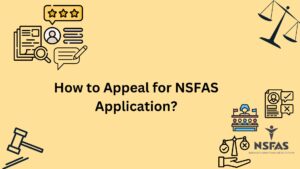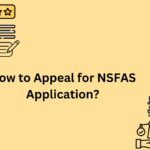Nsfas Appeal: A Complete Guide to the Appeal Process
If your NSFAS application was unsuccessful, don’t lose hope just yet. The NSFAS Appeal process offers a second chance for students to secure funding for their studies. This blog post provides a comprehensive guide on how to navigate the NSFAS Appeal process, including key details, eligibility criteria, and a step-by-step guide to ensure your appeal is successful.

Table of Contents
What is the NSFAS Appeal Process?
The NSFAS Appeal process allows students whose funding applications were initially unsuccessful to request a reconsideration. This process is designed to ensure that students who meet the requirements but may have encountered issues during their initial application have another opportunity to secure financial aid.
NSFAS Appeal Process: Key Details
The NSFAS Appeal process is an online procedure managed through the MyNSFAS portal. If your application was rejected, you could submit an appeal, providing additional motivation and supporting documents to justify why your application should be reconsidered.
Eligibility Criteria for NSFAS Appeal
To be eligible for the NSFAS Appeal process, you must have:
- Applied for NSFAS Funding: You must have submitted an initial NSFAS application.
- Received an Unsuccessful Status: Your application must have been marked as unsuccessful by NSFAS.
- Valid Reasons for Appeal: You must have a legitimate reason for the appeal, such as changes in financial circumstances or missing documents during the initial application.
How to Submit an NSFAS Appeal: A Step-by-Step Guide
Submitting an NSFAS Appeal is a straightforward process if you follow the steps carefully. Here’s how to do it:
Step 1: Log into Your MyNSFAS Account
Start by logging into your MyNSFAS account on the official NSFAS website www.nsfas.org.za. This is where you’ll track your funding application and manage the appeal process.
Step 2: Track Your Funding Progress
Once logged in, click on the ‘Track Funding Progress’ option. This will take you to the application progress tabs, where you can view the status of your application.
Step 3: Check Application Status
Review your application status. If it shows an “unsuccessful” message, you’ll have the option to appeal the decision.
Step 4: Click on ‘Submit Appeal’
Click on the ‘Submit Appeal’ tab to begin the appeal process. This will redirect you to the ‘Application Appeal’ page.
Step 5: Review the Reason for Unsuccessful Status
On the ‘Application Appeal’ page, you can see the specific reason why your application was unsuccessful. Understanding this reason is crucial for crafting a strong appeal.
Step 6: Write Your Motivation
You’ll need to write a motivation for why your application should be reconsidered. This motivation should clearly address the reason for your unsuccessful status. Keep it concise, as the motivation must not exceed 1000 characters (including spaces).
Step 7: Upload Supporting Documents
To strengthen your appeal, upload certified supporting documents that back up your motivation. You can upload up to five documents, so choose those that are most relevant to your case.
Step 8: Submit Your Appeal
Once you’ve completed your motivation and uploaded the necessary documents, click the ‘Submit Appeal’ button. Your appeal will then be processed by NSFAS.
Step 9: Track Your Appeal Progress
You can track the progress of your appeal through your MyNSFAS account. Regularly check for updates to stay informed about the status of your appeal.
Important Dates for NSFAS Appeal
The timeline for NSFAS Appeals is crucial, as missing deadlines can result in your appeal not being considered. Typically, NSFAS opens the appeal process shortly after the initial funding decisions are released. It’s important to stay informed about these dates:
- Application Deadline: Make sure you submit your initial NSFAS application before the deadline to be eligible for an appeal.
- Appeal Submission Period: The appeal submission window usually opens after funding decisions are made. Ensure you submit your appeal within this period.
- Response Time: After submitting your appeal, NSFAS will review it and provide a response. The timeframe for this varies, so check your MyNSFAS account regularly.
Common Reasons for NSFAS Appeal Rejections
While the appeal process provides a second chance, not all appeals are successful. Understanding common reasons for rejection can help you prepare a stronger appeal:
- Incomplete Documentation: Ensure all required documents are uploaded and certified.
- Insufficient Motivation: Your motivation should clearly explain why the initial decision should be reconsidered.
- Ineligibility: If you do not meet the eligibility criteria, your appeal is likely to be rejected.
Conclusion
The NSFAS Appeal process is an essential lifeline for students who were initially unsuccessful in securing funding. By following the steps outlined in this guide, you can increase your chances of a successful appeal. Remember to stay informed about important dates and ensure that your appeal is well-motivated and supported by relevant documents.
With persistence and attention to detail, the NSFAS Appeal process can open doors to educational opportunities that might have seemed out of reach. For more information visit www.nsfas.org.za
